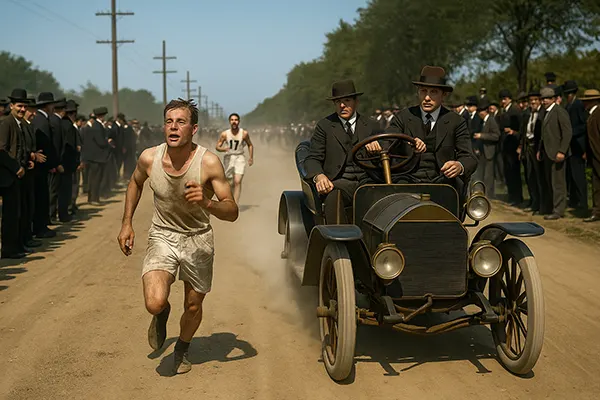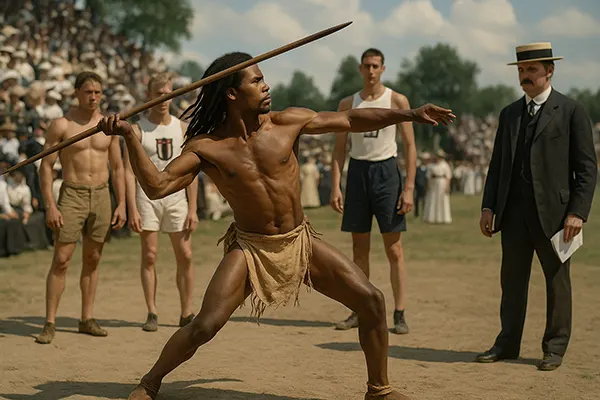Olympic Games 1904 in St. Louis: The Most Absurd Competition in Sports History

The 1904 Olympic Games held in St. Louis, Missouri, stand as one of the most controversial and chaotic episodes in the history of modern sports. Organised alongside the World’s Fair and heavily overshadowed by it, these Games were marred by poor planning, blatant racial discrimination, and a marathon that defied logic. Rather than a showcase of athletic excellence, the event became an example of how not to host an international competition. Let us examine what made these Games truly absurd and how their failures influenced the future of the Olympic movement.
The Marathon Disaster: A Farce in Motion
The marathon at the 1904 Olympics is perhaps the most infamous event of the entire Games. With temperatures reaching over 30°C (86°F) and limited access to water, the race became a test of survival rather than endurance. Organisers deliberately restricted water to test “purposeful dehydration”—a pseudoscientific theory with dangerous consequences. Of the 32 runners who started the race, only 14 finished.
One of the most bizarre incidents involved Fred Lorz, who after collapsing from exhaustion, hitched a ride in a car for over 10 miles. Feeling better, he re-entered the course and crossed the finish line first. Initially declared the winner, he only admitted the deception after being congratulated by officials and Alice Roosevelt, the daughter of the U.S. President. Lorz was subsequently disqualified.
Another participant, Thomas Hicks, won the event despite being administered strychnine mixed with egg whites and brandy by his coaches during the race—a form of doping that would be unthinkable today. He nearly died shortly after crossing the finish line, requiring immediate medical attention.
How the Marathon Reflects Poor Organisation
The marathon highlighted how inadequate the planning truly was. There was no proper course preparation, limited medical support, and almost no safety considerations. The dusty roads and open traffic further endangered athletes. Moreover, it exposed how American organisers prioritised spectacle over athlete welfare.
This chaotic race illustrated the dangers of pseudo-scientific experimentation in sports. The use of strychnine, now banned, showed the absence of any clear rules or health standards. It wasn’t until years later that the International Olympic Committee (IOC) would establish coherent doping regulations.
Perhaps most disturbingly, the marathon’s absurdity was celebrated rather than condemned at the time. It took decades for the Olympic movement to evolve from a nationalistic sideshow to a truly international competition governed by fairness and safety protocols.
The “Anthropology Days”: A Stain on Olympic Legacy
In an overtly racist event linked to the World’s Fair, organisers hosted what they called “Anthropology Days,” where indigenous people from around the world were invited to compete in pseudo-athletic contests. These were not official Olympic events, but they were closely associated with the Games and carried out under the same public spectacle.
Participants, who were from Africa, Asia, the Pacific Islands, and the Americas, were coerced into demonstrating their “athletic inferiority” in contrived contests like mud slinging, spear throwing, and tree climbing. The intention was not to honour these cultures but to mock them in front of white audiences.
This appalling display was driven by colonialist ideology and distorted the true spirit of international competition. Rather than promoting equality, it reinforced stereotypes and legitimised exclusionary policies in future Games. Pierre de Coubertin, founder of the modern Olympics, later condemned the event, although he had initially allowed it.
The Impact on Olympic Inclusion and Ethics
The backlash from Anthropology Days would spark early discussions around inclusion and representation. These disgraceful events revealed the dangers of mixing political propaganda with athletic competition. It made clear that the Olympic movement needed safeguards against racial discrimination and exploitation.
Over time, the IOC introduced more rigorous guidelines on athlete participation and removed pseudo-scientific and ethnographic demonstrations from any association with the Olympics. This shift was essential in transforming the Games into a more inclusive and ethical competition.
Though shameful, this episode ultimately contributed to the long-term reform of the Olympic ideals. The lesson: sporting excellence must never be used to justify social hierarchies or political ideologies.

Long-Term Consequences for the Olympic Movement
Despite its absurdities, the 1904 Olympics served as a turning point. The failures of the St. Louis Games prompted the IOC to reassess how the Olympics should be organised and presented. It was clear that pairing the Games with unrelated expositions created confusion and diluted the Olympic brand.
Future host cities were required to prioritise the Games and treat them as stand-alone events. The chaotic scheduling, lack of international participants (due to travel difficulties and poor promotion), and organisational bias towards American athletes would never be repeated on the same scale.
Moreover, St. Louis exposed the vulnerability of the Games to national interests. More than 500 of the 630 athletes were from the United States. This imbalance damaged the event’s credibility and helped drive the decision to form stronger international governing bodies within the IOC.
Legacy and Lessons Learned
The legacy of the 1904 Olympics is paradoxical. On one hand, it was a disaster. On the other, it laid the groundwork for modern reforms in sports ethics, fairness, and international governance. The absurdities of St. Louis catalysed a movement towards a more principled Olympic model.
From doping regulations to athlete safety, and from anti-discrimination measures to improved event management, many of today’s Olympic standards trace their origins back to lessons learned in 1904. Even the marathon—a race synonymous with endurance and heroism—became subject to global regulation after the St. Louis debacle.
In retrospect, the 1904 Games are often viewed as a cautionary tale. But they are also a key chapter in Olympic history—one that forced the movement to grow up, face its contradictions, and take steps toward real global sportsmanship.
